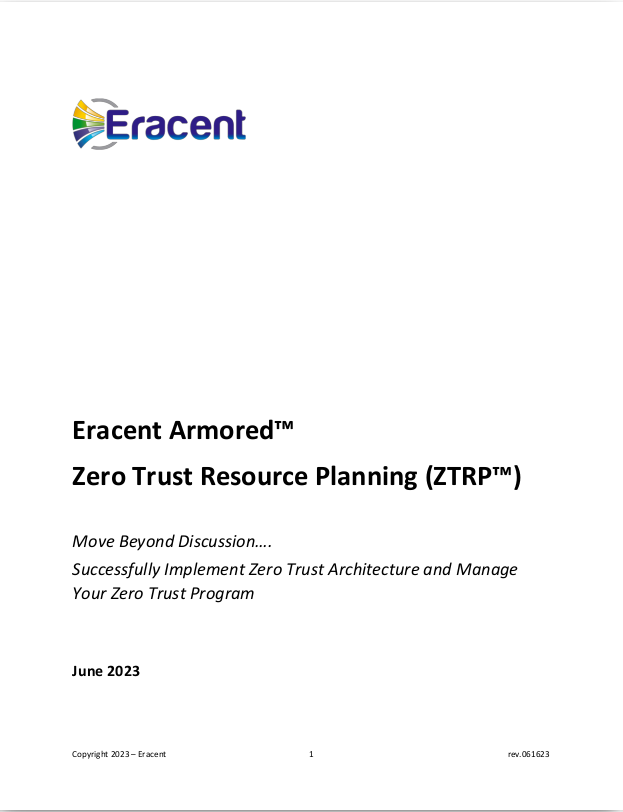Move Beyond Discussion… Successfully Implement a Zero Trust Architecture and Manage Your Zero Trust Program
Get your free Zero Trust Resource Planning white paper today!
Download the detailed, 16-page “Zero Trust Resource Planning” white paper free from Eracent.
Navigating the Obstacles to Implementing Zero Trust
Despite having implemented scores of specialized cybersecurity tools over the past decade, government and commercial enterprises continue to see uncontrollable waves of costly network and data breaches. As a result, the U.S. Federal Government is mandating the implementation of the Zero Trust Architecture. This mandate includes all Government agencies and will eventually include all vendors who provide goods and services to the U.S. Government.
The Zero Trust Architecture is a reality, but few organizations have implemented it to date due to several factors:
- First, there has been a tremendous amount of discussion about the concept and goals, but no prescriptive framework or guidelines for what to do, how to do it, and what a successful program would look like have been defined until now.
- Secondly, many vendors have created confusion by offering tools with niche functionality that address some specific aspect of the Zero Trust Architecture concept. They claim to offer Zero Trust Architecture solutions, when in fact they are one piece of a larger process.
- Zero Trust is a clearly defined, managed and continuously evolving process, it is not the random application of technology.
- Finally, most organizations can’t successfully implement Zero Trust because the discovery tools that they are using don’t provide the scope, accuracy and quality of data that is required as the foundation for Zero Trust activities. It’s essential to leverage an enterprise-level discovery process that covers 100% of physical and virtual endpoints, servers, locally-installed and cloud-based software, application and SBOM-level vulnerabilities, and more. Many discovery tools are designed to support a particular function like software license management or security, and in the end, are too restricted for the wide-ranging but stringent requirements of Zero Trust Architecture.
Implementing a Zero Trust Architecture Initiative
To move beyond the discussion and successfully implement an effective Zero Trust Architecture program, you need:
- A prescriptive set of guidelines
- An automated, continuous, and repeatable management process
- Tools that automatically provide all required data, a method for managing activities and process workflows, and a means of reporting on progress.
- The implementation of a continuous auditing and verification process – Zero Trust is not “one and done”.
To successfully plan and implement a program, you need to know:
- What are the specific objectives and goals of your Zero Trust program?
- What networks, endpoints, systems, and people are involved?
- What activities and tasks need to be defined, implemented, automated, and verified?
- How will the activities be completed (what’s the process)?
- Who is responsible for completing each task?
- How will progress be measured (method and metrics)?
- What work has been done to date?
- What work remains to be completed?
- What are the highest risks and priorities?
Eracent’s Zero Trust Resource Planning™ (ZTRP™)
Eracent offers a unique, framework-driven management process to support and expedite the implementation of a Zero Trust Architecture initiative. No matter what tactical security tools you are using, the Zero Trust Resource Planning (ZTRP) solution pulls together your tasks, processes, teams and systems. The result is complete visibility into your program, a single management and reporting platform, and automated, repeatable processes.
ZTRP includes a set of best practices for establishing a Zero Trust Architecture program that can be adopted and followed as-is, or they can be modified to meet your organization’s specific requirements.
The ZTRP platform provides intuitive framework management capabilities:
- All major activities are mapped out in a tree structure
- All systems, endpoints, installed software, vulnerabilities and people are linked to any other entities as appropriate.
- Tasks, activities, specific action items and policies are described and tracked throughout
- People responsible for each activity or process are assigned
- The frequency of each activity is designated
- Metrics and reporting contents are defined and can be modified to meet your organization’s needs.
Many activities in the ZTRP solution are automated and replicated, like following an instruction manual. This will save time and establish protection and results in an accelerated manner, while reducing the risk that any steps or systems have been overlooked. These controls ensure that your Zero Trust program is fully auditable, and it can seamlessly fit into a larger Risk Management program.
About ZTRP and the ICSP Platform
ZTRP is a focused application of Eracent’s Intelligent Cybersecurity Platform (ICSP), providing structured and automated process management to ensure that every endpoint and application is covered, and no critical steps are overlooked. Even if you are utilizing other tactical security applications for identification and mitigation, ZTRP brings all aspects of your cybersecurity and Zero Trust initiatives together and provides total visibility and centralized management and reporting.
Based on the broader ICSP platform, ZTRP is both framework-driven and flexible, enabling your organization to work towards meeting industry standards while supporting aspects that are unique to your program. ZTRP also provides very detailed reporting as well as summary dashboards to track metrics and monitor progress towards meeting your program’s goals.
ZTRP is a part of the Eracent Armored™ family of cybersecurity solutions from Eracent. Eracent has been providing exceptionally accurate and high-quality foundational data about enterprise-class networks, computing devices and software since 2000. Its highly scalable discovery, utilization, lifecycle management and data enrichment solutions are in use in some of the largest, most complex computing environments around the world.
Download Eracent’s detailed 16 page Zero Trust Resource Planning white paper now!
If you are a C-level Executive, Cybersecurity Professional, IT Admin, Application Developer, or Risk and Audit Specialist, this information-packed document will clearly show how ZTRP’s framework-based approach supports the successful implementation and ongoing management of Zero Trust programs. Share this with your team to ensure that planning for your program includes all essential elements.
You will also get a download of the ICSP Application Risk Management (ARM) white paper that details effective SBOM management and analysis. It outlines how to protect against Open Source component and library-level vulnerabilities and reduce the legal and financial risks of using improper open source license types.

Check out this newly published article by Eracent CEO William Choppa on the essential role of Zero Trust Resource Planning (ZTRP) in a world of breaches and their wide-reaching impacts on all of us. Implementing multiple cybersecurity tools doesn’t guarantee an effective Zero Trust program. Eracent’s ZTRP solution provides a management framework that ensures that every vulnerable point in your network is covered, defines how each one is being protected, and tracks who’s responsible. Reports and scorecards drive ongoing improvements. Contact info@eracent.com to learn more!





